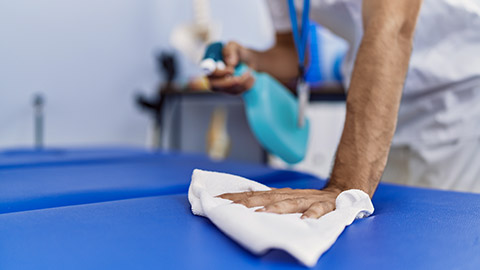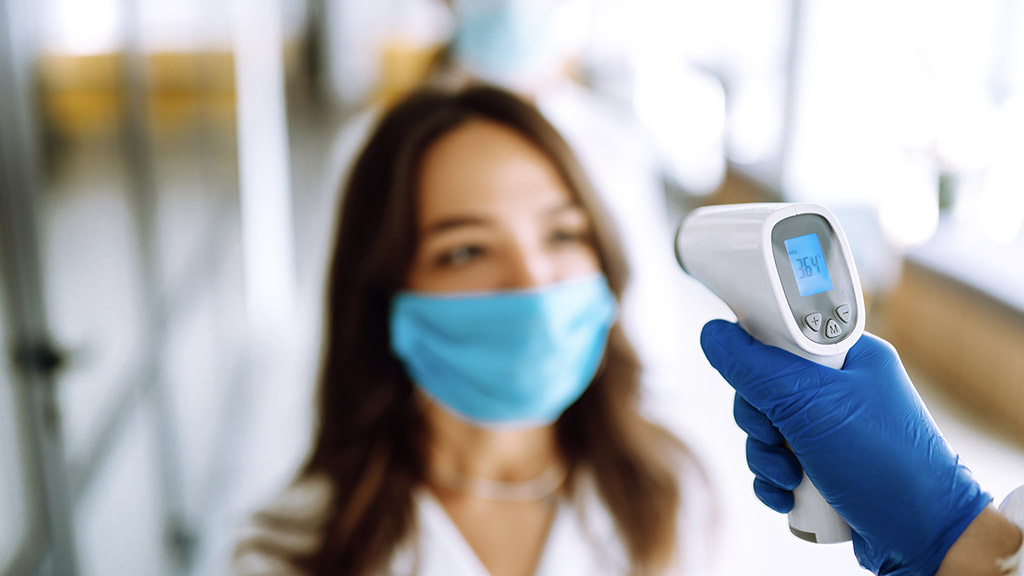Unit Title
HLTINF006 – Apply basic principles and practices of infection prevention and control
Unit Purpose
This unit describes the performance outcomes, skills and knowledge required to apply basic infection prevention and control principles in work settings including implementing standard and transmission-based precautions and responding to risks.
This unit applies to individuals working in a range of industry and work setting contexts.
Prerequisites
There are no pre-requisites for this unit.
Content
Section 1: Identifying the role of infection prevention and control
Section 2: Following standard and transmission-based precautions
Section 3: Responding to potential and actual infection risk exposure
Resources/Readings
Readings A – F are located in the associated HLTINF006 Readings.
Suggested Hours
Although everyone will work at their own pace, we suggest you allow approximately 35 hours to complete this unit competently, including seminars, tutorials, assignments, and skills demonstration.
Timeframe
The recommended time frame for this unit is 4 weeks.
Assessment
This unit will be assessed by completing the HLTINF006 Assessment.
How to Use This Module
This module and associated readings contain all of the information that you need to complete the assessment tasks associated with this unit. You must read through all of the information provided (both the module and associated readings) before attempting the assessment tasks.
Throughout this module there are a few icons used to help you. These include:
Tip
This is used to indicate the presence of tips or additional instructions that may assist you as you work through this module. They are designed to help you expand your knowledge and skills and deepen your understanding of how concepts and practices are applied in workplaces.
Read
You will find these throughout the module. They indicate that a particular Reading contains additional information on the topic that is being discussed at that point.
Reflect
This indicates a self-reflection question. You are not required to submit answers to these questions. They are designed to get you thinking more about the topic and to consider key points in order to aid your understanding.

Upon completion of this unit, you should be able to:
| Element | Performance Criteria |
|---|---|
| 1. Identify the role of infection prevention and control in the work setting | 1.1. Identify standards and guidelines relevant to own role and work setting. 1.2. Identify infection risks and hazards associated with own role and work setting. 1.3. Identify roles and responsibilities of self and others in relation to infection prevention and control. 1.4. Identify control measures to minimise risk in accordance with relevant national standards and guidelines. 1.5. Communicate effectively with others in relation to risk management. 1.6. Record identified risks and risk management strategies within scope of own role. |
| 2. Follow standard and transmission-based precautions for infection prevention and control in the work setting. | 2.1. Implement personal hygiene practices in the work setting. 2.2. Practice hand hygiene in accordance with national standards and guidelines. 2.3. Follow current national standards and guidelines for selection and correct use of Personal Protection Equipment (PPE) as required. 2.4. Follow procedures for environmental cleaning and management of waste. 2.5. Identify and respond to situations where transmission-based precautions or enhanced cleaning is required. |
| 3. Respond to potential and actual exposure to infection risks within scope of own role. | 3.1. Identify, respond to and communicate potential or actual risk of, or breach in, infection control. 3.2. Assess the risk and take appropriate immediate action in accordance with industry and organisational guidelines. 3.3. Communicate any breach in infection control and risk management strategies in place to the supervisor, manager or responsible authority and seek advice on actions required following a breach in infection control. 3.4. Implement control measures to minimise contamination of people, materials, and equipment. 3.5. Follow processes for management of spills and exposure to blood or body fluids. 3.6 Document incidents and responses and report according to organisational policies and procedures. 3.7. Ensure all records, materials and equipment are stored in a designated clean area. |
Knowledge Evidence
The candidate must show demonstrated knowledge required to complete the tasks outlined in elements and performance criteria of this unit:
- established national standards and guidelines for the prevention and control of infection
- types of infectious risks in the work environment and associated management to prevent and reduce harm
- causes of infection, including:
- classifications of microorganisms – bacteria, viruses, fungi, parasites
- process of colonisation, infection and disease
- transmission of infectious agents as per the chain of infection including:
- infectious agent:
- degree of pathogen exposure
- reservoir:
- people, animals and birds
- other vectors
- blood and body fluids
- food, water and soil
- waste
- portal of exit
- transmission:
- direct contact including contact, droplet and airborne
- indirect contact including surface or object contamination, penetrating injuries and vectors (animal, insect or parasite)
- portal of entry
- susceptible hosts:
- factors that increase susceptibility to infection
- infectious agent:
- personal hygiene practices:
- personal care and cleanliness
- use of clean clothing or uniform
- management and laundering of work clothing
- not attending work when ill
- safe respiratory and cough etiquette
- principles of hand hygiene:
- hand care, including guidelines on maintaining intact skin, fingernails and jewellery or watches
- hand hygiene procedures:
- identifying when hand hygiene is required
- identifying correct hand hygiene product
- hand hygiene technique
- procedure for applying alcohol-based hand rub
- when to perform hand hygiene with soap and water rather than alcohol-based hand rub
- precautions where there are breaks in the skin or skin conditions
- 5 moments of hand hygiene
- safe and effective use of different types and grades of Personal Protective Equipment (PPE) including:
- masks
- gloves
- protective eyewear and face shields
- gowns and aprons
- techniques and sequence for applying, fitting and removing PPE
- preventing contamination while applying, wearing and removing PPE
- safe disposal of PPE after use
- cleaning procedures:
- routine environment and equipment cleaning
- enhanced cleaning
- reprocessing of reusable equipment or instruments
- managing a blood or body fluid spill
- management of linen and clothing
- principles of asepsis relevant to the job role
- waste management procedures:
- disposal of general waste
- safe handling and disposal of contaminated waste
- safe handling and disposal of sharps
- organisational policies and procedures for:
- managing exposure incidents
- recording and documenting risks and incidents
- reporting risks and incidents
- parties to whom reports may be made:
- supervisor
- general practitioner
- health care professional
- carer
- responsible person
- responsible authority.
Performance Evidence
The candidate must show evidence of the ability to complete tasks outlined in elements and performance criteria of this unit in the context of the job role, and:
- implement precautions for infection prevention and control according to national standards and guidelines on three different occasions, each responding to a different identified infection risk, including:
- carrying out hand hygiene procedures as relevant to the infection risk
- selecting and using correct Personal Protective Equipment (PPE)
- using correct cleaning and waste management procedures
- respond to three instances of exposure to infection risk, including:
- at least one instance that involves management of exposure to blood or body fluids
- documenting and reporting the incident and response
- identifying and managing clean and contaminated zones.

This unit is designed to introduce you to the knowledge and skills of working with professional and industry practices of applying basic principles and practices of infection prevention and control. In a variety of health contexts, you will learn about professional standards and guidelines and identifying risks and control measures to achieve best practice in the Allied Health field.
Overview of Sections
Section 1: Identifying the role of infection prevention and control setting
In this section, you will learn more about standards and guidelines, as well as infection risks and hazards in a work setting. With this professional focus, you will develop your understanding in roles and responsibilities of self and others and how to identify control measures to minimise risk. In this, you will learn how to identify and respond to requirements of transmission-based precautions.
Section 2: Following standard and transmission-based precautions
In this section, you will learn more about how to engage with organisational policies and procedures and implement personal hygiene practices. This will include standards and guidelines for hand hygiene and safe protocol of hand hygiene. You will also be learning about relevant Personal Protection Equipment (PPE), along with environmental cleaning and management of waste procedures.
Section 3: Responding to potential and actual infection risk exposure
In this section, you will learn more about how to identify and respond to risk exposure, including industry and organisational guidelines to assess and take appropriate immediate action. You will learn about implementing control measures to minimise contamination, management of spills and exposure, how to document report and respond, shaped by organisational policies and procedures and storage of records, materials and equipment.
Copyright ownership: Australian Institute of Professional Counsellors Pty Ltd ACN
077 738 035
The learning content and assessments are copyright protected under the Berne Convention. All rights reserved. No reproduction without permission.
Australian Institute of Professional Counsellors Head Office 47 Baxter St., Fortitude Valley, QLD 4006.
This learning content and assessments are protected by copyright and may not be reproduced or copied either in part or in whole nor used for financial gain without the express approval in writing of the owner (Australian Institute of Professional Counsellors Pty Ltd ACN 077 738 035) of the copyright.

